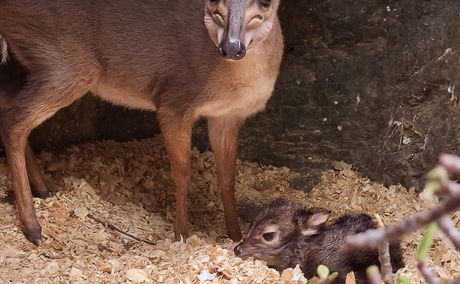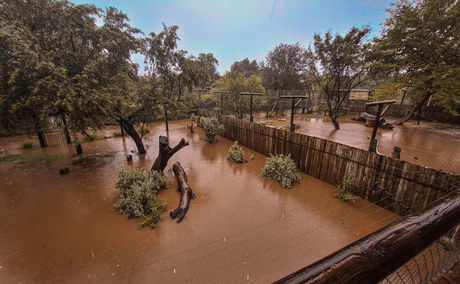In a quiet corner of our facility, something tiny, tawny, and utterly magical has been making hearts melt – and we’re thrilled to officially share the news. Our team recently conducted a gentle gender reveal for the newest member of our Blue Duiker family, and after careful observation (and a little patience), we’re happy to report that our dainty antelope calf is female! We’ve named her Holly, after the Cape Holly trees...
Hanging in there...

Ahead lies a monumental week for us as our CWR family expands! Not by 1 or 2… but by 3! Choloepus didactylus, more commonly known as Linnaeus’s Two-toed Sloths, will be joining the CWR family from 10 May 2021. Our Zoological team is abuzz with excitement and all efforts are being made to prepare their new home.
We have powered through one of the most challenging times in our facility’s history. Our sails had never been so windless and our fundraising endeavours were drained. There was always one constant though, and that was to get through lockdown and open our doors again! The pandemic threw the world a curve ball and we were not prepared. At the time, we were in the planning stages of a new exhibit when the virus spread. Everything we had planned, ground to an extreme halt, and after 35 years, we had to close our doors to the public, thankfully only temporarily. More than a year later and so much has changed! This past year taught us determination like no other, that having faith is fundamental and that innovation is not an option, sometimes it is a sheer necessity. More than anything though, it has taught us how much Cango Wildlife Ranch means to so many and the support that we received was overwhelming. As things slowly returned to ‘normal’, we decided to make our new exhibit a reality once again! Amazonia, now a token of thanks to our dedicated supporters and another wonderful part of the world that we will be able to highlight and educate the public on daily.
Ahead lies a monumental week for us as our CWR family expands! Not by 1 or 2… but by 3! Choloepus didactylus, more commonly known as Linnaeus’s Two-toed Sloths, will be joining the CWR family from 10 May 2021. Our Zoological team is abuzz with excitement and all efforts are being made to prepare their new home.
Also known as the Southern Two-toed sloth, it takes its name from the two curved claws at the end of each limb. The impressive biology of a sloth allows it to spend 90% of its life hanging upside down which is made possible by their organs being attached to their rib cage to eliminate pressure on the lungs. This means that, unlike us, a sloth can hang upside down with no effect on its breathing what-so-ever. As sloths go, these are considered large with an average length of around 65cm. Their hair parts from the stomach downwards to their back, allowing water to run off in rainstorms, and its natural tan colour is often tinged with green from algal growth. Unique grooves in the hair facilitate this growth of algae, which helps camouflage the sloth against predators. To conserve energy, sloths move slower than any other mammal on the planet. This modest pace means that sloths generally travel no more than 38 meters in a single day, and on the rare occasion that they find themselves at ground level, they crawl only 30 cm per minute.
Sloths are notoriously leisurely in all aspects of their life and only descending from the canopies to move from one tree to another or to defecate. When they are on the ground, they are extremely vulnerable to predation, and as a result, they have bladders and rectums with a very high capacity, allowing them to wait as long as a week before descending! They range from Venezuela and Colombia into eastern Ecuador, as far south as Peru and across to the Atlantic coasts of northern Brazil. Our sloths have joined us from a centre called Noah’s Ark, and now form part of only 3 accredited facilities in South Africa to house these magnificent creatures. We are hard at work to ensure that their habitats meet all their tropical needs, and they will therefore find temporary sanctuary in our Tropical Temple in the ‘Valley of Ancients’ while we complete their state-of-the-art home in Amazonia.
Recently, legendary naturalist Sir David Attenborough, sat down with BBC Earth to answer some of his most frequently asked questions, the most recurrent being, ‘If you could be any animal for a day, what would it be?’ Without hesitation Attenborough responded, ‘A sloth’! Sleeping up to 20 hours a day, hanging around with little to do and beloved by all - sounds about as good as it gets!
Over the past 2 decades, mainstream media has also highlighted the gentle nature of these mellow slowpokes, significantly increasing public interest and curiosity, and we cannot disagree, they are truly remarkable animals worthy of all their notoriety. To fully admire and appreciate these fascinating beings, please visit Cango Wildlife Ranch in Oudtshoorn – where you can meet Sid, Wookie and Shaggy.
Further Reading
Prickles came into our care as a tiny, wide-eyed orphan—rescued after his mother was tragically killed by dogs on a nearby farm. From that moment on, he became part of our family, wrapped in warmth and raised with the kind of love and devotion that only a little abandoned porcupine could inspire.
The Flood That Tested Us – and the Strength That Carried Us Through Exactly one year ago, on 4 June 2024, Cango Wildlife Ranch faced one of the most devastating natural events in our 40+ year history. Today, we pause—not to relive the hardship, but to reflect on the resilience, bravery, and unity that saw us through.
















Share This Post